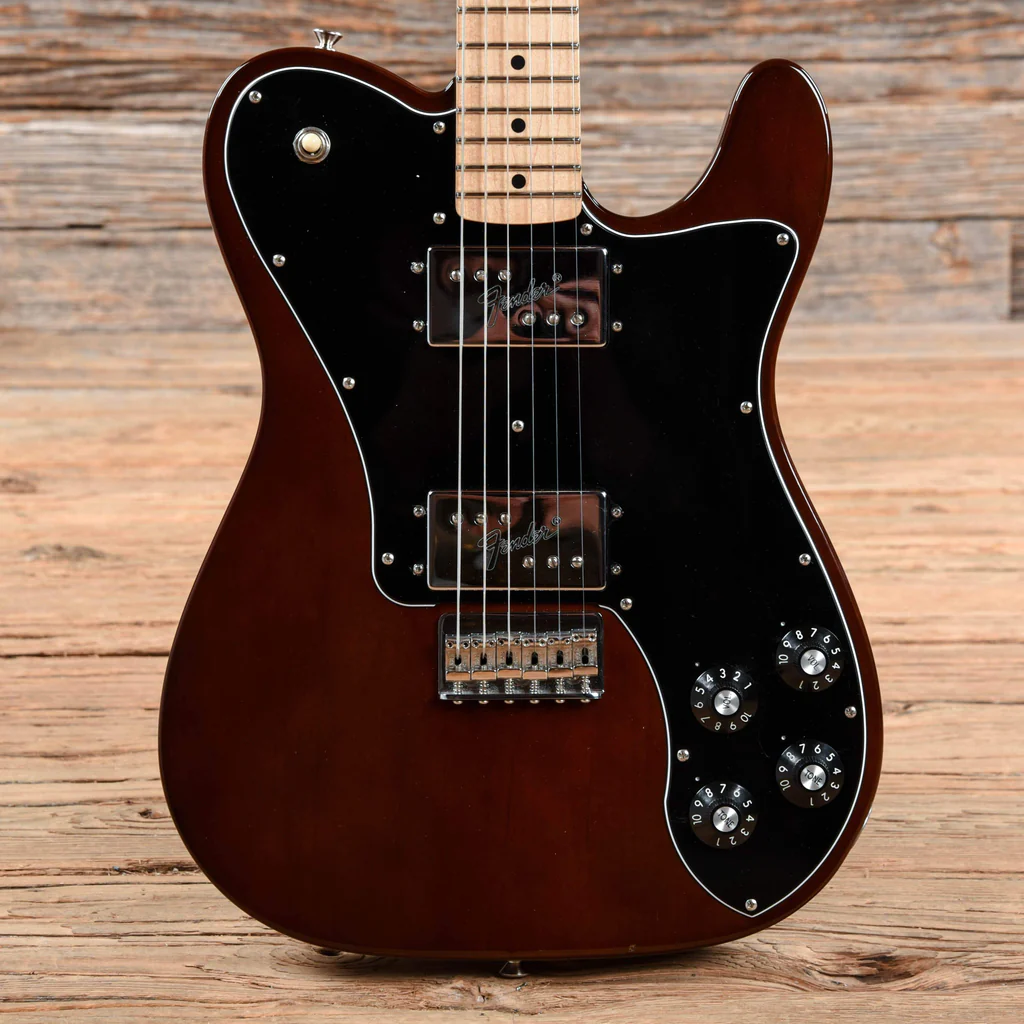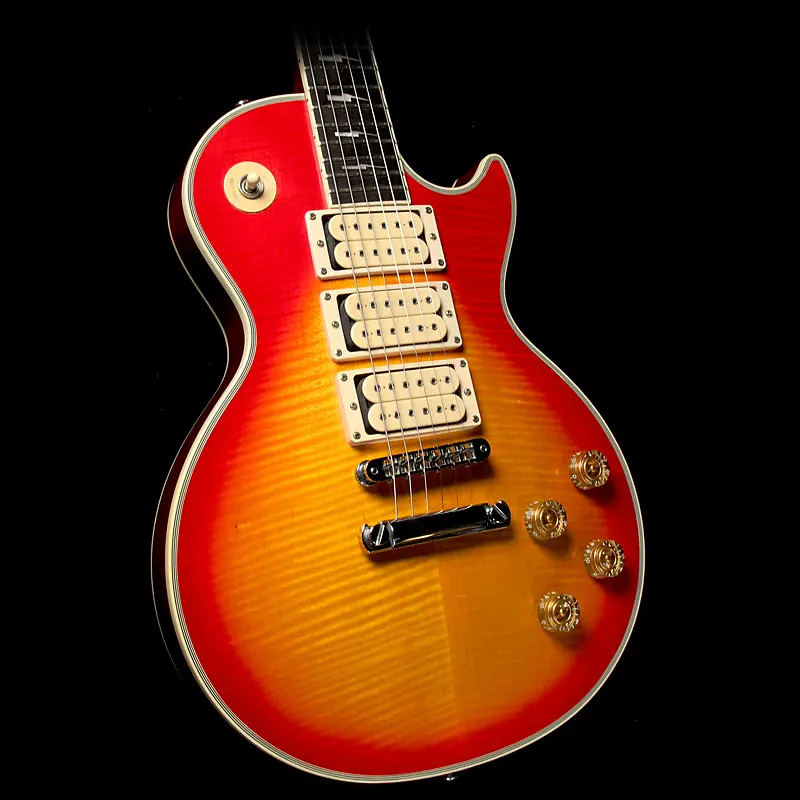
All images courtesy of Getty Images/Wiki Commons
VWMusic’s Editor, Andrew Daly, and Staff Writer, Anthony Montalbano, take a moment to run through ten guitars that have managed to imprint themselves via their looks, as well as their utility.


By Andrew Daly & Anthony Montalbano
[email protected]/[email protected]
It was probably in the late ’90s, from the early to mid-2000s, that we started discovering music on our own. That’s when things shifted from casual observation to actually paying close attention, both lyrically and musically, to the nuances of the music.
As we grew older, the guitar began to emerge front and center. The sounds, different setups, gear, and the like presented unique soundscapes, encapsulating our adoration for the music as it pertained to all things guitar. Indeed, it’s a bit of a revelation to not only see but hear how one single instrument can be so beautifully complex and customizable while remaining a tool toward greater execution.
When it comes to the guitar, the possibilities are seemingly endless, which only adds to its grandeur. In the right hands, it can aid in committing acts of infamy, splendor, and downright jaw-dropping theatrics. From simple musings to displays of virtuosity, everyone – and every curio – plays their part and has their role. And so, we’ve decided to count down ten guitarists whose rigs have inspired us over the years.

Artist: Zach Blair/Tim McIlrath of Rise Against
Guitar: “Nowhere Generation” Epiphone Les Paul’s
As chosen by Anthony Montalbano
It’s no hidden secret that my favorite band is Rise Against, and they are my most-seen live band to date. I have specific memories tied to every show I’ve seen them play, with the most recent being in 2022, on the Nowhere Generation Tour. Their onstage energy, McILrath’s vocals, and Blair’s masterful playing were only matched by the smile painted on their faces.
As for the guitars they featured, there were two black and white themed Epiphone Les Pauls. One was adorned with the album title on the body, with mirrored inlays on the fretboard, and was used by frontman Tim McIlwrath. The other was a half-and-half black and white split down the middle, used by the band’s lead guitarist Zach Blair. Both guitars are said to be powered by Seymour Duncan SH-4 JB Humbucking pickups, leaving these guitars capable of performing a wide range of tracks spanning Rise Against’s discography without skipping a beat.

Artist: Johnny Marr of the Smiths, Electronic, Modest Mouse, the Cribs, etc.
Guitar: Gibson 12-String ES-355
As chosen by Andrew Daly
Of course, I could have gone with the Rickenbacker 330, with which Marr’s chiming tones are most associated in his Smiths days. And sure, I might have been inclined to include the Fender Jaguar that he’s been perpetually infatuated with in his latter years, ala Modest Mouse and the Cribs. But no, I’ve chosen Marr’s more interesting – to my ears – Gibson ES-335, which was of the 12-string variety, for those keeping score.
Marr has always been a quasi-minimalist, ushering in unique textures without interjecting bloated solos, something I’ve always appreciated. As per reports, Marr was heavily inspired by past run-ins with Gibson’s semi-hollow line, but during the recording of Straysways Here We Come (1987) – Marr’s favorite Smiths LP – he wanted to add something more substantial, prompting him to deploy Gibson’s 12-string curio across “Stop Me If You Think You’ve Heard This One Before.”
To be sure, you’ll want specs. Here goes: The body is constructed of laminated maple, with a solid maple center block running down the center of the body, giving a warm tone and limiting the feedback problem at higher volumes. The one-piece mahogany neck is comfortable and topped with a dark rosewood fretboard, accented with binding and block inlays. Marr didn’t mess with the pickups – they’re PAF Humbuckers, and the Gibson tuners also remained. This may not be Marr’s most famous guitar, but its relevance spans much further than its notoriety.

Artist: Claudio Sanchez of Coheed and Cambria
Guitar: Epiphone G-1257 Custom Double Neck
As chosen by Anthony Montalbano
One of the last live shows I attended before the pandemic shut the world down was unforgettable. The show featured The Story So Far, Coheed and Cambria, and Taking Back Sunday. Like many others, my discovery of Coheed and Cambria came in the wake of their hit single “Welcome Home,” where the music video and the guitar have become synonymous. As for Sanchez’s Epiphone G-1257, that guitar featured a standard 6-string underneath a 12-string, and I loved the moment I saw it.
Seeing the guitar live was a treat, and I knew exactly what I was in for when the lights came down and popped back up with Claudio mid-stage holding the iconic double neck. Featuring an Alnico Classic Open Coil Humbucker in the neck position and an Alnico Classic Plus Open Coil Humbucker on the bridge, both the six and 12-string sides are similar, with the coils being encased in nickel.

Artist: Bruce Kulick of Meat Loaf, Blackjack, KISS, Union, Grand Funk Railroad, etc.
Guitar: ESP M-1, aka “The Banana Guitar”
As chosen by Andrew Daly
Kulick has used many guitars over the years, but what he’s perhaps most associated with – at least, when it comes to his KISS days – is the ESP M-1 line. Indeed, as a player resenting the proverbial “shred-era,” Kulick – a member of a hot-ticket band – had many options to choose from, but in the end, went with upstart Japanese brand Electric Sound Products, aka ESP. Though to be fair, at one point, Kulick preferred Jackson and Charvel guitars, but in the end, his connection with ESP was stronger.
If you’re a KISS fan, you don’t need to be a guitar aficionado to recall Kulick’s line of lovely ESP M-1 guitars, with the “M-1′ standing for “Metal Guitar.” To be sure, you’ve seen Kulick’s “Flip-Flop Blue” model with a Rosewood fingerboard, often used during the Asylum era, and the red “Radioactive” unit was a big part of the Crazy Nights promotional cycle. But for my money, Kulick’s most iconic M-1 falls to the gorgeous yellow “Banana Guitar,” with its cheeky Chiquita sticker placed below the strings by KISS’s road crew, for looks, of course.
At some point, Kulick settled on passive pickups, adding Seymour Duncan Custom pups to his simple two-knob guitar, which, per era standard, sported a lovely black Floyd Rose tremolo. And while I love all of Kulick’s M-1 guitars, his bright yellow “Banana guitar” has to be my favorite. With a rock-solid Strat-style neck and aforementioned specs, the tonal quality and playability are excellent and are a massive part of KISS’s late-80s sound, which featured Kulick’s stylings front and center.

Artist: Matt West of Neck Deep
Guitar: Reverend Matt West Custom Signature
As chosen by Anthony Montalbano
Used in the music video for “In Bloom” and often played live, the Custom Reverend used by Matt West features a single 9A5 pickup, which is proprietary to the guitar itself. Paired with an Orange Amp head and an Orange 4×12 cab, this thing absolutely screams, matching the energy of Neck Deep to perfection.

Artist: Keith Richards of the Rolling Stones
Guitar: ’53 Fender Telecaster, aka “Micawber”
As chosen by Andrew Daly
Keith Richards is known to brandish a Tele or three now and again, so including his beloved ’53 six-string… err… five-string, which he affectionately calls “Micawber,” shouldn’t be much of a surprise. Sure, I could have included Richards’ well-worn black ’72 Deluxe, but the truth is, “Micawber,” with its juxtaposed Humbker at its neck, is what inspired Fender’s ’72 line in the first place.
Richards has used “Micawber” many times since being gifted the guitar by Eric Clapton in 1970 for his birthday, and I feel it would be useless to recount the tracks he’s deployed it on. Instead, for the uninitiated, I’ll remind you that it was with this guitar that he began experimenting with alternative tuning, aka 5-string Open G. In short, Richards removed the upper E string and accompanying saddle and tuned the guitar in a droning, open chord, creating an iconic sound that would be duplicated en mass after that.
But first, Richards decided to install a Gibson PAF Humbucker at the neck, swapping out the original single coil. Of course, he did so backward, with pole pieces facing away from the neck. Richards also moved to replace the single-coil bridge pickup with a Fender Champion lap steel pickup. Lastly, Richards replaced the bridge with a custom Schecter brass bridge with individual saddles and installed modern Sperzel locking tuners. These mods, paired with his 5-string tuning, created the guitar sound we know and love today.

Artist: Synyster Gates of Avenged Sevenfold
Guitar: Schecter Custom S
As chosen by Anthony Montalbano
It’s no secret Synyster Gates’s guitar of choice is a Schecter Custom S. Gates is known to boast a massive collection of Schecter guitars, with many different models to choose from. Still, the finest, in my opinion, is Gates’s Custom S signature model. Sporting sleek black and shimmering gold pinstripes and glittering “Deathbats” inlaid on the fretboard, the Custom S is eye-popping and nothing short of beautiful both on and off the stage. As for specs, Seymour Duncan SH-8 Invaders and Sustaining neck pickups adorn its mahogany body. It comes with the tried and true Floyd Rose 1500 tremolo bridge for ultimate pitch control and tuning stability. In short – the Custom S is a metal shredder’s wet dream.

Artist: Jimmy Page of Led Zeppelin, The Firm, etc.
Guitar: Danelectro 3021/DC-59
As chosen by Andrew Daly
It would be all too easy to key in on Page’s ’59 Les Paul or the initially psychedelic and later brown-painted ’59 Tele that Jeff Beck gifted him. Instead, I’ve gone with Page’s ’61 Danelectro 3021/DC-59. With its unique lipstick single-coil pickups and semi-hollow Masonite meets poplar construction, the DC59 was a work of spaced-out tech that only a company positioned just outside the mainstream could afford to take a chance on.
Page didn’t use the guitar often per se, but it was deployed on Yardbirds turned Led Zeppelin cut “White Summer/Black Mountain.” But the DC59 is most well-known for its deployment across 1975’s “Kashmir,” with Zeppelin’s guitar-maestro stunning listeners with cascading riffage akin to a hypnotic trek across the desert. The Danelectro DC59 is an oddball, to be sure, but it’s iconic nonetheless.
Its choral depth is singular, and its downright weird construction and simplistic pickups give it a sound unto itself. In short, the guitar sounds like no other, which is probably why Page only trusted it for spot duty. The DC59’s bolt-on poplar neck has a rosewood fretboard, and you can spot this thing from a mile away with its unique “Coke bottle” shaped headstock. The open-back three in-line tuners are distinct but not nearly as memorable as its pickups constructed from Alnico bar magnets and copper wiring wrapped in brown tape and mounted in what was quite literally surplus chrome-plated lipstick tubes.

Artist: Eddie Reyes of Taking Back Sunday
Guitar: Fender Classic Series ’72 Telecaster Deluxe
As chosen by Anthony Montalbano
Of course, I had to include a Fender. I could have chosen many, but I ultimately went with Eddie Reyes ’72 Telecaster Deluxe model featured in Fender’s Classic Series. During the aforementioned Coheed and Cambria show, Taking Back Sunday was the second act and in the process of promoting its Tidal Wave record. To this day, the show remains one of my favorites, with Taking Back Sunday coming hot and finishing utterly explosive.
As for Reyes’s Tele, it’s perhaps an obvious choice for the genre, with Fender’s flagship solidbody being perpetually seen throughout the pop-punk community. Bands such as All Time Low, State Champs, Motion City Soundtrack, Fallout Boy, and countless more have sued it. Some say that Fender lost the plot with the infamous ’72 model, but still, it has its supporters. With an alder wood body and maple neck, any Tele is great for high-energy performances. Of course, the ’72 shed the classic single-coil pickups, featuring Wide Range Humbucking pickups, making it different, but to my ears, the ’72 remains equally as versatile.

Artist: Ace Frehley of KISS and Frehley’s Comet
Guitar: ’97-2001 Custom Signature Gibson Les Paul
As chosen by Andrew Daly
When it comes to Ace Frehley, aside from his off-brand affair with Washburn guitars in the ’80s – the Ace Frehley AF-40V 1986-87 Black Lightning Bolt – he’s always been a Gibson man. Of course, the “Spaceman” is said to have used Fender Strats in the studio, but we’ll save that for another day. So, yeah, the Les Paul is sort of Frehley’s thing. I could have chosen just about any single-cut from any era; indeed, it would have held up.
I chose Frehley’s ’97-2001 Signature Custom Les Paul for no reason other than he was playing the guitar in concert the first time I saw him perform. As a kid, I became obsessed with KISS, and Frehley’s Cherry Sunburst model became iconic for me with his lack of pickguard and three pickups. And, of course, who could forget that Frehley’s kabuki-clad mug was printed dead-center across the headstock? Iconic, indeed. As far as construction and specs, the guitar is based on past models which Frehley has played dating back to the ’70s, incorporating mods that Frehley himself made along the way.
Like most Les Paul’s, the body is made of mahogany, as is the neck. You’ve got your Stop-Bar tailpiece, 24.75″ scale length, and a gorgeous flamed maple top. As for pickups, as per usual, Frehley chose DiMarzio’s Super Distortion pups, while the neck and middle pickups are DiMarzio PAFs. Frehley’s Custom Les Paul’s twenty-two frets are adored in ebony, with tiny – and very on-brand – lightning bolts imprinted. And if we move up toward headstock, we’ve got nickel-plated Grover tuners with square pearloid buttons. In the years since Frehley has unleashed other signature models, but KISS’s Reuion-era Les Paul will always hold the most significance for me.
– Andrew Daly is the Editor-in-Chief of www.vwmusicrocks.com and may be reached at [email protected] & Anthony Montalbano is a Staff Writer for www.vwmusicrocks.com and may be reached at [email protected]
